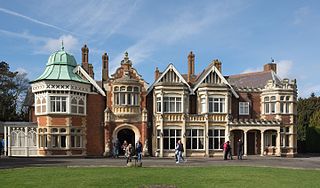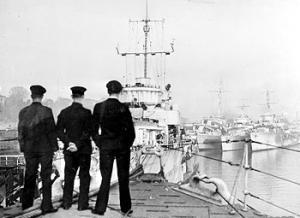
Bletchley Park is an English country house and estate in Bletchley, Milton Keynes (Buckinghamshire) that became the principal centre of Allied code-breaking during the Second World War. The mansion was constructed during the years following 1883 for the financier and politician Sir Herbert Leon in the Victorian Gothic, Tudor, and Dutch Baroque styles, on the site of older buildings of the same name.

The Battle of the Atlantic, the longest continuous military campaign in World War II, ran from 1939 to the defeat of Nazi Germany in 1945, covering a major part of the naval history of World War II. At its core was the Allied naval blockade of Germany, announced the day after the declaration of war, and Germany's subsequent counter-blockade. The campaign peaked from mid-1940 through to the end of 1943.

The Powerhouse Museum is the major branch of the Museum of Applied Arts & Sciences (MAAS) in Sydney, the others being the historic Sydney Observatory at Observatory Hill, and the newer Museums Discovery Centre at Castle Hill. Although often described as a science museum, the Powerhouse has a diverse collection encompassing all sorts of technology including decorative arts, science, communication, transport, costume, furniture, media, computer technology, space technology and steam engines.

The Diefenbunker, formerly known by its military designation, Canadian Forces Station Carp (CFS Carp), is a large underground four-storey reinforced concrete bunker and nuclear fallout shelter located in the rural area of Carp, Ontario approximately 30 km (19 mi) west of downtown Ottawa. Between 1957 and 1961, during the Cold War the Government of Canada led by then Prime Minister John Diefenbaker authorized the Diefenbunker to be designed and built as the Central Emergency Government Headquarters (CEGHQ Carp) in an attempt to ensure the continuity of government subsequent to a nuclear weapons attack by the Soviet Union. In 1994, CFS Carp was decommissioned and closed.

Admiral Sir Max Kennedy Horton, was a British submariner during the First World War and commander-in-chief of the Western Approaches in the later half of the Second World War, responsible for British participation in the Battle of the Atlantic.

The Churchill War Rooms is a museum in London and one of the five branches of the Imperial War Museum. The museum comprises the Cabinet War Rooms, a historic underground complex that housed a British government command centre throughout the Second World War, and the Churchill Museum, a biographical museum exploring the life of British statesman Winston Churchill.

Crewe Heritage Centre is a railway museum located in Crewe, England. Managed by the Crewe Heritage Trust, the museum is located between the railway station and the town centre; the site was the location of the 'Old Works' which was demolished in the early 1980s.

The Montreal Holocaust Museum is a museum located in Montreal, Quebec, Canada, that is dedicated to educating people of all ages and backgrounds about the Holocaust, while sensitizing the public to the universal perils of antisemitism, racism, hate and indifference. Through the museum, its commemorative programs and educational initiatives, it aims to promote respect for diversity and the sanctity of human life. The Museum was founded in 1979 as the Montreal Holocaust Memorial Centre and is Canada's first and only recognized Holocaust museum.

HMCS Alberni was a Flower-class corvette that served in the Royal Canadian Navy (RCN) during the Second World War. The Flower-class corvettes were warships designed for anti-submarine warfare. The ship was constructed by Yarrows Ltd. in Esquimalt, British Columbia, laid down on 19 April 1940, launched on 22 August and commissioned on 4 February 1941. The corvette sailed east to join the RCN's fleet in the Atlantic via the Panama Canal, where upon arrival, the vessel began escorting trans-atlantic convoys in the Battle of the Atlantic. Alberni took part in the key convoy battle of Convoy SC 42. In 1942, the corvette was transferred to Allied convoy assignments associated with Operation Torch in the Mediterranean Sea. In 1944, Alberni was among the Canadian naval vessels assigned to Operation Neptune, the naval component of the invasion of Normandy and escorted support ships to and from the United Kingdom on D-day.

Commander-in-Chief, Western Approaches was the commander of a major operational command of the Royal Navy during World War II. The admiral commanding, and his forces, sometimes informally known as 'Western Approaches Command,' were responsible for the safety of British shipping in the Western Approaches.

The Museum of Oxford(MOX) is a history museum in Oxford, England, covering the history of the City and its people. The museum includes both permanent and temporary displays featuring artefacts relating to Oxford's history from prehistoric times to the present day. The museum also acts as a public meeting space which people and organisations rent for both public and private events. Other activities facilitated by the museum include frequent public talks by historians and local cultural organisations, organised school tours, family activities, adult learning workshops, and an older people's program.
Canadian Northwest Atlantic Command was the zone of operations during the Battle of the Atlantic that stretched from north of New York City to 47 degrees west. It was set up at the Atlantic Convoy Conference, held in Washington, D.C., from 1–12 March 1943, and placed under the command of Rear-Admiral Leonard W. Murray on 30 April 1943 with its headquarters in Halifax, Nova Scotia. It was notable for being the only Allied theatre of operations commanded by a Canadian during the war.

HMS Ferret was a shore establishment and naval base of the Royal Navy during the Second World War, located in Derry. It was given a ship's name as a stone frigate.

Grey Roots Museum and Archives began as a County museum in 1955. Since then it has taken a large role in preserving the history and promoting the heritage of Grey County.

The Centre for Computing History is a museum in Cambridge, England, established to create a permanent public exhibition telling the story of the Information Age.

The Royal Air Force Museum Cosford, located in Cosford in Shropshire, is a free museum dedicated to the history of aviation and the Royal Air Force in particular. The museum is part of the Royal Air Force Museum, a non-departmental public body sponsored by the Ministry of Defence and also a registered charity. The museum is spread over two sites in England; the other site is at the Royal Air Force Museum London at Colindale in north London.

The Montrose Air Station Heritage Centre is located to the North of Montrose, Angus, Scotland. Montrose has the distinction of having the first operational military airfield in Great Britain and the Heritage Centre is located on the former airfield. It aims to show the human side of its history with a collection of contemporary photographs, artefacts and memorabilia. These not only tell of the history of the airfield but also the story of the men and women who served there and those who lived in the area.

Kosovo Museum is the National Museum of Kosovo, located in the city of Pristina. Founded in 1949 by Yugoslav authorities, it is the largest museum in Kosovo, located in an Austro-Hungarian-style building from 1889 that previously served as the high military command headquarters.

Exchange Flags is a Grade II listed building in Liverpool, England. It is laid out in a 'U' shape, with Walker House situated on the west side and Horton House on the east side. Walker House was adapted during its construction to include a reinforced bunker that housed the Western Approaches Command Headquarters, the command centre for the campaign waged against the German submarine fleet during the Second World War. The courtyard faces Liverpool Town Hall and contains the Nelson Monument.
The Western Approaches Tactical Unit (WATU) was a unit of the British Royal Navy created in January 1942 to develop and disseminate new tactics to counter German submarine attacks on trans-Atlantic shipping convoys. It was led by Captain Gilbert Roberts and was principally staffed by officers and ratings from the Women's Royal Naval Service (Wrens). Their primary tool for studying U-boat attacks and developing countermeasures was wargames. After the U-boat threat to merchant shipping was defeated, WATU continued to develop anti-submarine tactics for later stages of the war, including Operation Overlord and the Pacific War. WATU trained naval officers in its tactics by hosting week-long training courses in which the students played wargames. WATU formally ceased operations at the end of July 1945.



















